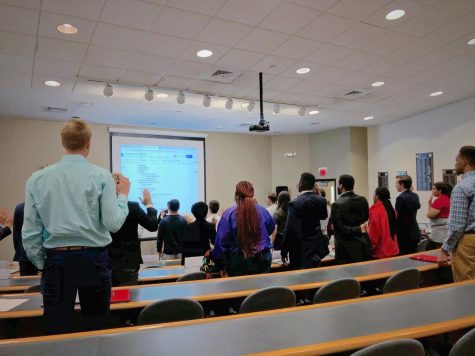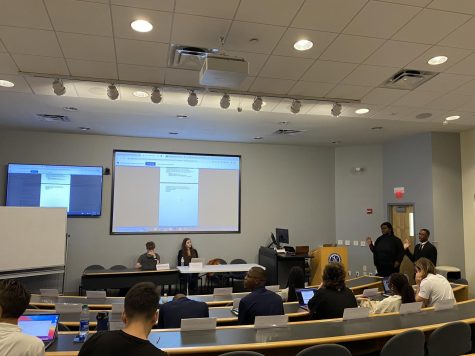Women are a minority in many positions of Student Government
There are plenty of women in student government but not enough are in top leadership roles
March 26, 2019
At a school that constantly advertises its diversity, where 43 percent of students are male and 57 percent are female, women make up only a fraction of the student government leadership positions.
While women are prevalent in many parts of student government, there’s a clear distinction between gender in key leadership roles.
The gender disparity does not only exist in appointed positions of student government — the recent presidential and gubernatorial election highlighted the fact that most of the candidates were men.
Gender differences in the recent SG election
Presidential candidates:
Three candidates ran for student body president — Kevin Buchanan, Jonathan Marr, and Neasha Prince, with Prince as the only woman.
In contrast, all the vice presidential candidates — Celine Persaud, Kitana Thomas, and Leona Robinson — were women.
Celine Persaud, the vice president-elect, found the all-female ticket ran by Naesha Prince and Leona Robinson inspiring.
Persaud called it encouraging because “the tide is starting to turn.”
The last female student body president at FAU was Emily Lawless last Fall.
“For a long time, men have predominantly been serving these leadership roles within student government, which means that men have been making the majority of the decisions that affect women’s experience at FAU too,” Persaud said.
Persaud emphasized that women provide unique insight on many issues they face at college campuses.
“Threats to women’s safety, health, and opportunity on campus are important issues that women in leadership roles can effectively address,” she added.
While also discouraged by the small number of women candidates running for president, Persaud said, “incoming women should never deprive themselves of the opportunities that FAU has to offer — always believe in yourself.”
As vice president, Persaud will serve as the leader of the Senate and will play a key role in allocating the university-wide budget.
Campus governors:
Missing from the stage during this year’s Boca gubernatorial race was a female candidate. All three Boca candidates — Elijah Colas, Javier Bravo, and Alexander Zand — were men.
Last year, Der’Resha Bastien was the Boca campus governor. She was noted by a previous Boca campus Justice, Sayd Hussain, for her fiscal responsibility. This was due to the comparatively low cost of her campus address as compared to campus governor, Luke Turner, who came under fire for his spendings.
The Davie campus’ only candidate, a woman named Melissa Carasa, ran unopposed.
Currently, only one out of the three campus governors is female.
The outgoing governor, Luke Turner, appointed an all-female cabinet. The cabinet includes the Boca chief of staff, marketing director, and campus treasurer.
The all-female cabinet is unique in that it was the only department of SG that was entirely female.
However, this department of SG was again representative of the trend that the main leadership positions are held by men, while the associate positions are held by women.
Across branches, men hold most key leadership positions
As far as numbers are concerned, the House is by far the most balanced. There is a nearly even split of men and women representatives in the House.
Yet for committee chairs, only one of the three committees is chaired by a woman.
Kitana Thomas is chairwoman of the Ways and Means Committee and was also a vice presidential candidate. She is responsible for the distribution of student activity and service (A&S) fees that are collected yearly in tuition.
The primary leadership positions, the speaker of the House and pro tempore, are both held by men.
In comparison, the Boca senate consists of three male senators and is led by Marianne Alex, who currently serves as vice president as the chair of the Senate.
Having been a member of the House since her freshman year, Marianne Alex has dedicated much of her time at FAU to be the highest ranking woman currently in student government.
She quickly climbed the ranks in SG, becoming speaker pro tempore in her sophomore year and speaker of the House in her junior year.
While her attempt to become student body president in the spring of 2018 was unsuccessful, her platform championed mental health awareness, sexual assault awareness, transportation and safety, and campus improvement.
As the president of the Senate, she is a member of the University Budget Allocation Committee, otherwise known as UBAC, which oversees the university budget A&S fees.
In the judicial branch, there are no women.
In fact, the student court consists of justices from the three campuses, all of whom are men, including the Chief Justice.
The judicial branch, which is tasked with determining the constitutionality of student government statutes and sits on the Student Code of Conduct Hearing Board, is devoid of a female perspective.
The lack of female representation can have an adverse effect when hearing cases that involve women’s issues.
The UP reached out to Marianne Alex but did not hear back in time of publication.
Ending the gender gap in SG
Celine Persaud noted that gender disparity in student government is not unique to FAU, and is simply a symptom of a greater societal trend.
“The problem is that women are poorly represented throughout all levels of government and unfortunately that is true at the student level as well,” Persaud said.
While the recent midterm election brought the greatest number of women serving in the United States Congress, the House of Representatives is only 24 percent women while the Senate is only 25 percent women. The Supreme Court has the highest percentage of women, which is a mere 33 percent.
Persaud stated that solving the gender gap starts with women taking the initiative in seeking positions of power.
“It is important to have at least half of the student government leaders and officials be female to effectively represent the student body’s needs. This starts with getting involved and inspiring other women to be involved as well,” Persaud said.
With time, student government should work on having equal representation of women and all other groups that are not numerically represented.
What are the branches of Student Government?
The gender disparities in each branch of government differ.
Judicial Branch: (Student Court)
The Student Court consists of a chief justice and three campus associate justices. The judicial branch through the Student Court has jurisdiction over cases involving questions of interpretation, application or interpretation of the student government constitution and student body statutes.
Legislative Branch: (House and Senate)
Senate: The Student Senate consists of nine campus senators, three from the Boca Raton, Broward, and Jupiter campuses. The Senate is chaired by the student body vice president. The Senate’s primary responsibilities are presiding over university-wide statutes, presidential appointment approvals, and the university-wide budget allocation process.
House: The Campus Houses of Representatives can write, or sponsor legislation such as bills, simple resolutions, and joint resolutions. The House will then vote or veto and upon approval will be sent to the executive branch for vote or veto.
Executive Branch: (Office of President and Governor)
The executive branch is elected leaders who are responsible for the planning and execution of programs, projects, and services provided to the student body. Key players include the president, the vice president, and the cabinet.
Ross Mellman is the managing editor of the University Press. For information regarding this or other stories, email [email protected] or tweet him @RossMellman.















